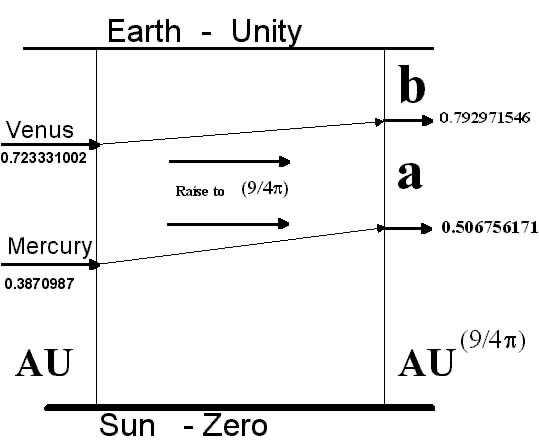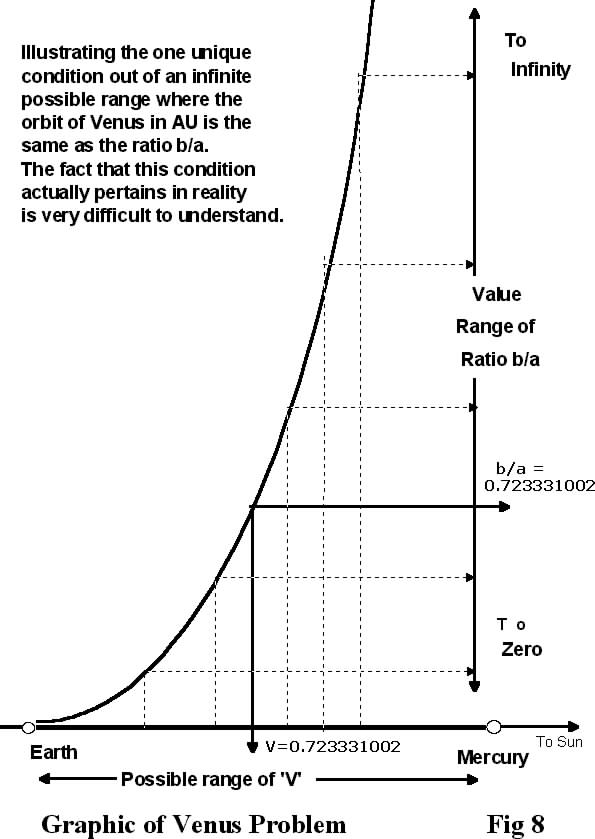Illustrating the problem of Venus
and the ratio b/a.

|
Genesis Site Math Menu Part 3 Mean orbit of Venus & Probability |
|
The Mean Orbit of Venus. Let us suppose that we do not know the orbit of Venus. We may assume we know the orbit of Earth, at unity, and the orbit of Mercury, at 0.3870987 AU. We also know that orbits should be raised to the power (9/4p).
Earth, at unity, remains as unity when raised to any power. Mercury becomes 0.506756171.
We do not know Venus, but we may call it 'V', and when raised to the power (9/4p) we may refer to it as V(9/4p) .
The following statement is true :-
If we do not know the orbit of Venus, then we can use this expression to calculate it by successive approximation. There is only one solution to this equation, and close examination reveals that the value of V is determined by the value of V. Venus determines its own orbit, or appears to.
The solution is .............. 0.723331002 Nortons figure for Venus is 0.7233322
The orbit of Venus and the Pythagorean ratios b/a and B/A are all the same numerical value.
|
|
Fig 7 Illustrating the problem of Venus and the ratio b/a. 
|
|
The possible range of the ratio b/a is from zero to infinity, depending on the orbit of Venus in relation to Mercury and Earth. Considering that there is no scientific reason for the planet Venus to exist at all, the probability that the ratio would turn out to be numerically the same as the orbit of Venus in astronomical units is infinitely small. There is only one orbit where this condition can apply, and Venus 'just happens' to find itself in that unique orbit, with a precision which is hard to explain, (five digits, see fig 8).
|

|

|
|
Ubiquity of ratio b/a. The elements 'c' and 'C' are both products of the values 'a' and 'b' (By Pythagoras). It follows that without exception, all the orbits of the Solar System are mathematically related to the orbit of Venus, but the orbit of Venus can be calculated from the Venus equation, which is composed only of 'V' itself, and some constants. (Mercury and Earth form part of the calculation, their orbits are represented simply as two constants.)
|
|
The problem of Astronomical Units. The maths for the solar system works only with astronomical units as a unit of measure, and this raises a problem, since this unit is supposedly an arbitrary unit based on the orbit of the Earth. It is not supposed to be of cosmic significance. The Solar System graph and the main Equation are founded on the universal mathematical constant p, which means that the equation is a 'pure math' equation. The equation works with any units, even inches, provided the input value is less than p . There is no reason why any of the planets should be 'unity' on the scale of zero to p. The fact that Earth is unity is a mystery, except and unless the system uses astronomical units as a fundamental cosmic constant ! The same mystery applies to the orbit of Venus, which is equal to the ratio b/a. Now a ratio is just a number, whatever units are used, and 0.723331002 is a number which would not change even if the system worked in inches. The mystery is why it should be the same as Venus, when Venus is measured in A.U. It cannot be coincidence, because the ratio is determined by the orbit.
|
|
Summary 1) The major orbits of the Solar System are contained within and described by the main equation. 2) The ratio b/a and of course B/A is equal to the orbit of Venus but is also determined by the orbit of Venus. This is not simply an approximation, it is accurate to five decimal places, and unique. This ratio pervades the whole Solar System. (See section at top of this page) 3) The equations are bi-directional, an inner orbit could be calculated from an outer orbit. 4) The orbits can be calculated from Pythagoras. 5) The orbits can be calculated with the use of trigonometry. 6) The implied triangles are all similar, and similar to a triangle constructed from Venus/Earth mean orbits. 7) Orbits can be calculated by adding and subtracting constants. 8) Equations allow orbital distances to be interchanged with orbital periods. 9) Any orbit can be calculated from any other, and all the orbits can be calculated from any two. 10) The orbits can be calculated by a number of different routes from any datum orbits. Deviations from Nortons data will vary very slightly depending on the route taken. |
|
Probability Calculations The main equation, the one that defines the graph, is not astronomical in nature, it is pure maths. The equation describes the orbits very accurately. All the mathematical relationships described are factual, can be verified by anyone motivated to do so, and are accurate to within a fraction of one percent. Scientific theory would insist that the orbits of the planets are due entirely to chance. Science must show that the Solar System could conform to a mathematical scheme by the operation of random forces, or abandon the established theory that the Solar System originated by chance. Science can calculate the probability that the System could conform to a mathematical scheme by chance alone.
This writer calculates probability based on calculated 'degree of disorder' which should be large (over 50) but is in fact extremely small. (2.5% in 900, or 0.0028) This gives a probability figure of one chance in 3.8 x 1030 . That is the probability that the orbits will match one mathematical pattern, but it could be argued that they match with more than one pattern, they match Pythagoras as well, and so we might like to square that number, to give one chance in 1.45 x 10 61
There are an estimated 1.6 x 1023 stars in the whole visible universe, that is not enough to equal the figure we calculated for the probability above. In order to make the number of stars closer to the calculated probability, we would have to square the number of stars in the visible universe, we would need the sum total of stars in as many universes as there are stars in our own universe. Since a star can only ever have one system of planets, we may say that the odds against our Solar System being in accord with a mathematical scheme by chance alone are one chance in a number equivalent to as many stars as have ever existed in the whole history of the visible universe, squared.
|
|
Conclusions
According to 20th century scientific theory, the Solar System originated from a nebulosity of dust by the action of gravity and chance. We have seen that the orbits of the planets obey mathematical rules, that is to say, the Solar System is nonrandom. We may safely conclude that the Solar System did not come about by the operation of chance. Humanity has been misled for the last two hundred years. Science is wrong.
|
G.Curtis November 22 1999.
|
Top of this page | Math Menu |
Next Section Final Design |
Summary of Equations |
Page